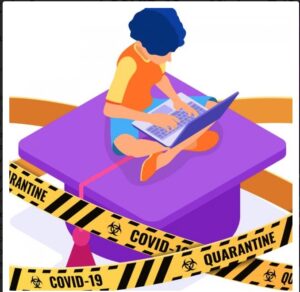
COVID-19 is disrupting education on an unprecedented scale. A framework that has depended primarily on face-to-face interaction in school buildings is now operating almost entirely virtual.
This rapid shift has dampened confidence among both teachers and students and has exposed growing inequalities in higher learning institutions.
A Pew Research Center survey conducted in April stated roughly half of U.S. adults (53 percent) says the Internet is essential for them during the pandemic; versus another statistic (34 percent) described Internet access as “important, but not essential.”
Due to COVID-19, years of curriculum have abruptly moved fully online as schools closed. Lectures are now held virtually on Zoom while assessments have turned digital. As learning switches to remote platforms, there is a new divide between those who benefit from virtual learning and those who cannot.
Disparities in access to computers, home Internet connection, and direct instruction has widened the gap between the nation’s least fortunate and wealthiest schools.
In her blog post titled “The remote teaching shift from response to recovery,”Vanessa Dennen, Program Coordinator for ISLT at Florida State University, explains the importance of instructors developing relationships with their students during this difficult time.
“Instructors and students won’t be able to capitalize on pre-existing classroom relationships. They won’t be visualizing each other in the classroom, but instead will find themselves interacting remotely with strangers. Instructors are going to need to establish identity and presence for themselves, and to encourage students to do the same.”
Social distancing guidelines have caused the closure of libraries, recreational centers, and non- essential businesses, which many students relied on to complete assignments.
Without these essential spaces, many students have lost access to their main source of internet and computers. The disruption of remote modes of learning can cause long term consequences — especially for the most vulnerable.
“The abrupt transition from in person instruction to virtual instruction affected my learning capabilities by effectively diminishing my want to learn,” said Savina Edwards, a senior psychology major attending the University of West Georgia. “I haven’t been able to exactly focus on certain subjects because of the setting I’m in, which is too comfortable.”
Schools and universities can offer all the educational technology in the market to support their students, but without Internet or even a mobile data plan that can access its tools, it becomes impossible for students to continue to take classes.
In terms of reopening schools, there is the risk of breaking the safe boundaries of social distancing and increasing the transmission of infection.
Although the Internet is an intensely visual and sound-related medium, students with physical impairments must be accounted for as well.
Consequently, learning institutions will have to grasp the fact that many students may not learn effectively without in-person classes.
In the event that schools do remain virtual for a significant period of time, it will become mandatory for administrations to comply with the Americans with Disabilities Act (ADA).
The pandemic has not created these disparities, but rather highlighted and worsened its existing disparities. Schools and higher learning institutions will need to increase investments to meet the social, emotional, and mental health needs of their students who will be struggling with the stress and traumas of this pandemic.
Virtual alienation and technical demands that many do not have access to is leaving students with no options.
This complex crisis offers a time of reckoning.